Unit 1 Our living planet 单元词汇课件(共32张PPT)-2025-2026学年 译林版(2020)选修第一册
文档属性
| 名称 | Unit 1 Our living planet 单元词汇课件(共32张PPT)-2025-2026学年 译林版(2020)选修第一册 | 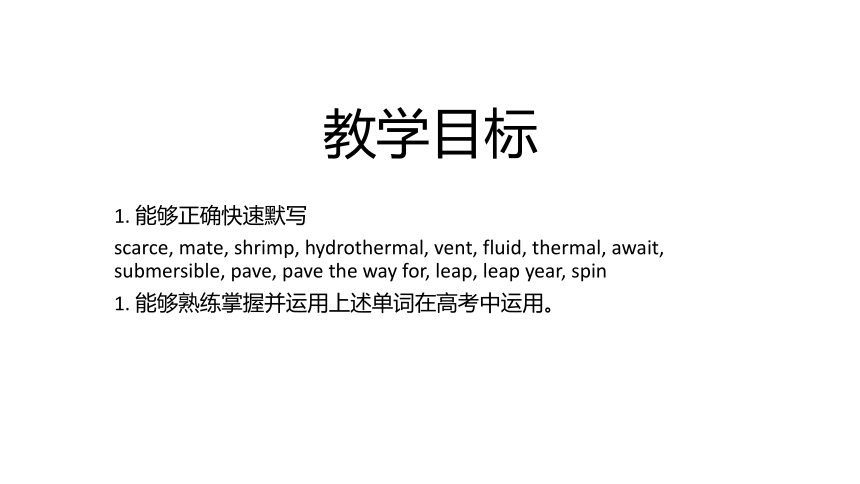 | |
| 格式 | pptx | ||
| 文件大小 | 166.0KB | ||
| 资源类型 | 教案 | ||
| 版本资源 | 牛津译林版(2019) | ||
| 科目 | 英语 | ||
| 更新时间 | 2025-06-17 21:24:52 | ||
图片预览



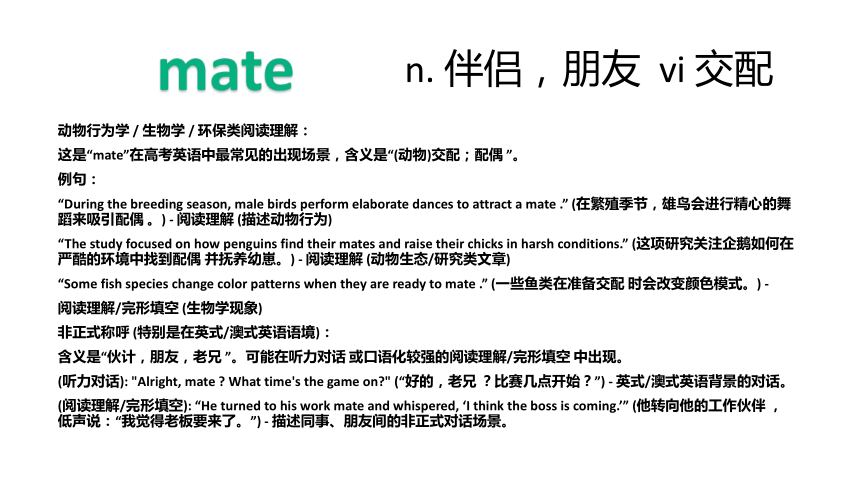

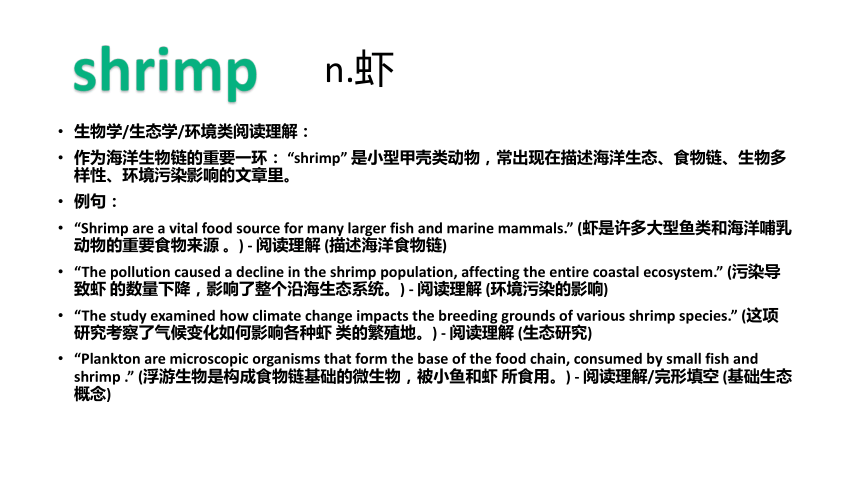
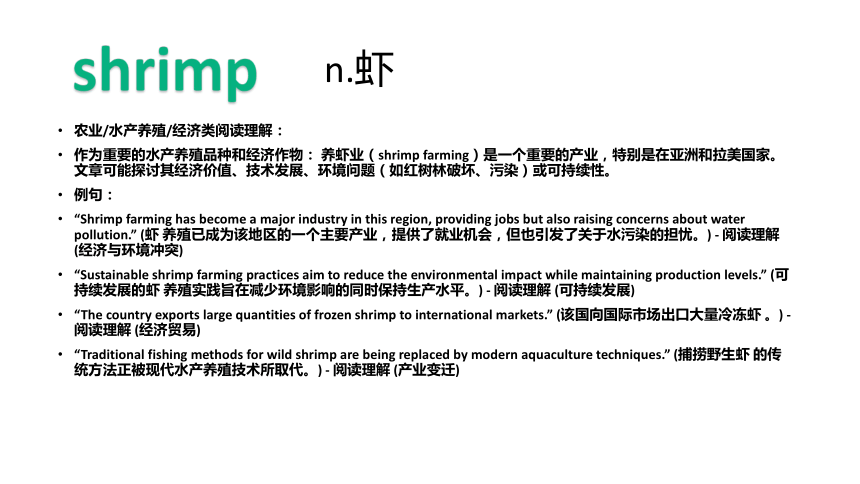


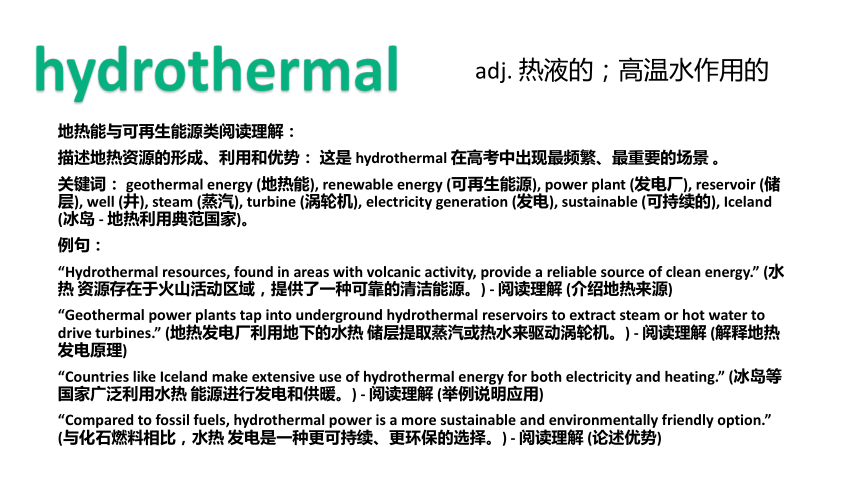

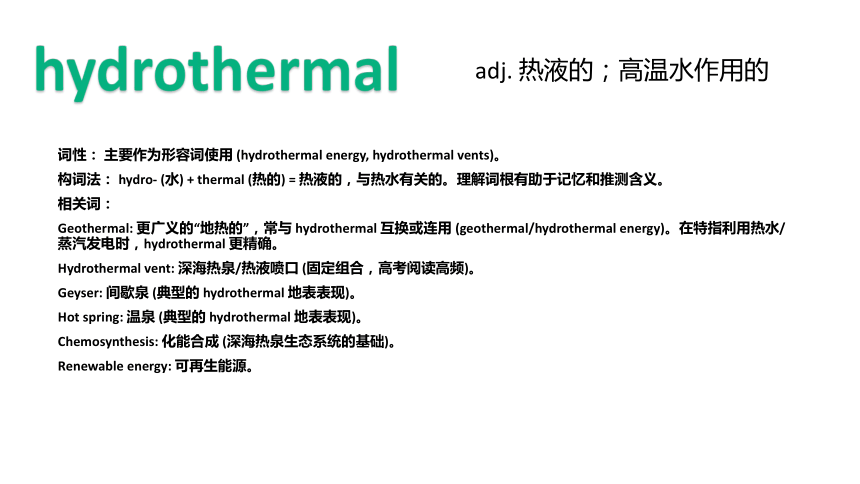
文档简介
(共32张PPT)
教学目标
1. 能够正确快速默写
scarce, mate, shrimp, hydrothermal, vent, fluid, thermal, await, submersible, pave, pave the way for, leap, leap year, spin
1. 能够熟练掌握并运用上述单词在高考中运用。
adj. 缺乏的,稀少的
阅读理解:
直接在文章中出现描述资源、机会等稀少的状态。理解“scarce”的含义对把握文章主旨(如资源危机、挑战)或细节至关重要。
可能出现在“细节理解题”、“推理判断题”或“词义猜测题”中(虽然“scarce”本身难度适中,但可能被要求推断其同义表达或理解其语境含义)。
完形填空:
空格处需要一个形容词来描述某种资源、物品或机会的状况,选项中可能出现“scarce”以及它的近义词(如 limited, rare, insufficient, inadequate)或反义词(如 abundant, plentiful, sufficient)。需要根据上下文(如描述短缺、困境、需求大但供应少)来选择“scarce”。
常与以下词汇搭配出现:
make sth. scarce: 使某物稀缺
become scarce: 变得稀缺
scarce resources: 稀缺资源
in scarce supply: 供应短缺
due to scarcity: 由于稀缺性
语法填空:
可能性相对较低,但可能在形容词位置出现,需要根据上下文判断其形式(原形即可)。
scarce
adj. 缺乏的,稀少的
写作:
这是一个非常实用的词汇,可用于描述各种“短缺”问题来支持论点或说明现状。
常用表达:
Facing scarce resources, we must... (面对稀缺资源,我们必须...)
The scarcity of [water/jobs/funding] poses a serious challenge... ([水/工作/资金]的稀缺性构成了严峻挑战...)
With opportunities becoming scarce, ... (随着机会变得稀缺,...)
find ways to cope with the scarcity of... (找到应对...稀缺的方法)
scarce
n. 伴侣,朋友 vi 交配
动物行为学 / 生物学 / 环保类阅读理解:
这是“mate”在高考英语中最常见的出现场景,含义是“(动物)交配;配偶 ”。
例句:
“During the breeding season, male birds perform elaborate dances to attract a mate .” (在繁殖季节,雄鸟会进行精心的舞蹈来吸引配偶 。) - 阅读理解 (描述动物行为)
“The study focused on how penguins find their mates and raise their chicks in harsh conditions.” (这项研究关注企鹅如何在严酷的环境中找到配偶 并抚养幼崽。) - 阅读理解 (动物生态/研究类文章)
“Some fish species change color patterns when they are ready to mate .” (一些鱼类在准备交配 时会改变颜色模式。) -
阅读理解/完形填空 (生物学现象)
非正式称呼 (特别是在英式/澳式英语语境):
含义是“伙计,朋友,老兄 ”。可能在听力对话 或口语化较强的阅读理解/完形填空 中出现。
(听力对话): "Alright, mate What time's the game on " (“好的,老兄 ?比赛几点开始?”) - 英式/澳式英语背景的对话。
(阅读理解/完形填空): “He turned to his work mate and whispered, ‘I think the boss is coming.’” (他转向他的工作伙伴 ,低声说:“我觉得老板要来了。”) - 描述同事、朋友间的非正式对话场景。
mate
n. 伴侣,朋友 vi 交配
注意: “classmate” (同班同学), “roommate” (室友), “teammate” (队友) 等复合词是非正式场合下对人称呼 的延伸,在高考中更多是以完整复合词形式出现。
搭档/伙伴(中性含义):
含义是“伙伴,搭档 ”,不如“partner”常用,但在描述合作、配对关系时可能出现。
例句:
“The chess champion carefully considered his next move with his mate (或者更常用 partner) against the opponents.” (这位国际象棋冠军和他的搭档 仔细考虑了对对手的下一步棋。) - 描述游戏或活动的伙伴关系。
“He was chosen as the captain's mate on the voyage.” (他被选为船长航行的副手 。) - 航海或特定情境 (在高考中较少见)。
作为动词 (动物交配):
在动物类文章中,它也可能作为动词出现。
例句: “These birds mate for life.” (这些鸟终生交配 。) - 阅读理解 (描述动物习性)。
mate
n.虾
生物学/生态学/环境类阅读理解:
作为海洋生物链的重要一环: “shrimp” 是小型甲壳类动物,常出现在描述海洋生态、食物链、生物多样性、环境污染影响的文章里。
例句:
“Shrimp are a vital food source for many larger fish and marine mammals.” (虾是许多大型鱼类和海洋哺乳动物的重要食物来源 。) - 阅读理解 (描述海洋食物链)
“The pollution caused a decline in the shrimp population, affecting the entire coastal ecosystem.” (污染导致虾 的数量下降,影响了整个沿海生态系统。) - 阅读理解 (环境污染的影响)
“The study examined how climate change impacts the breeding grounds of various shrimp species.” (这项研究考察了气候变化如何影响各种虾 类的繁殖地。) - 阅读理解 (生态研究)
“Plankton are microscopic organisms that form the base of the food chain, consumed by small fish and shrimp .” (浮游生物是构成食物链基础的微生物,被小鱼和虾 所食用。) - 阅读理解/完形填空 (基础生态概念)
shrimp
n.虾
农业/水产养殖/经济类阅读理解:
作为重要的水产养殖品种和经济作物: 养虾业(shrimp farming)是一个重要的产业,特别是在亚洲和拉美国家。文章可能探讨其经济价值、技术发展、环境问题(如红树林破坏、污染)或可持续性。
例句:
“Shrimp farming has become a major industry in this region, providing jobs but also raising concerns about water pollution.” (虾 养殖已成为该地区的一个主要产业,提供了就业机会,但也引发了关于水污染的担忧。) - 阅读理解 (经济与环境冲突)
“Sustainable shrimp farming practices aim to reduce the environmental impact while maintaining production levels.” (可持续发展的虾 养殖实践旨在减少环境影响的同时保持生产水平。) - 阅读理解 (可持续发展)
“The country exports large quantities of frozen shrimp to international markets.” (该国向国际市场出口大量冷冻虾 。) - 阅读理解 (经济贸易)
“Traditional fishing methods for wild shrimp are being replaced by modern aquaculture techniques.” (捕捞野生虾 的传统方法正被现代水产养殖技术所取代。) - 阅读理解 (产业变迁)
shrimp
n.虾
饮食文化/生活方式/健康类阅读理解或完形填空:
作为常见食材: 出现在介绍不同国家饮食文化、健康饮食、烹饪方法或餐厅场景的文章中。
例句:
“Seafood, including shrimp , is a popular choice in coastal regions.” (海鲜,包括虾 ,在沿海地区很受欢迎。) - 完形填空 (饮食文化)
“Shrimp is low in calories but rich in protein and certain minerals.” (虾 热量低,但富含蛋白质和某些矿物质。) - 七选五 (健康饮食)
“The menu featured grilled shrimp with lemon butter sauce.” (菜单特色是柠檬黄油酱烤虾 。) - 阅读理解/完形填空 (餐厅场景)
“He ordered the pasta with shrimp .” (他点了带虾 的意大利面。) - 完形填空 (点餐情境)
听力部分:
餐厅点餐对话: 在听力对话中,尤其是涉及点餐场景,“shrimp” 很可能作为一道菜(如 shrimp cocktail, grilled shrimp, shrimp salad, shrimp fried rice)被提及。
生物课/环境课讨论: 听力材料涉及生物/环境话题时,可能包含关于虾的生态作用、养殖或保护的内容。
日常对话(购物/做饭): 谈论买海鲜或烹饪海鲜时可能提到。
完形填空和语法填空:
在上述主题(生态、养殖、饮食)的故事或叙述性段落中,作为名词出现填空,通常需要根据上下文判断单复数 (shrimp / shrimps - 注意:复数形式 shrimps 较少见,通常 shrimp 本身可表示复数)。
可能考查其作为不可数名词(指虾肉)的用法(如:a pound of shrimp)。
shrimp
n.虾
写作(特定主题):
如果写作题目涉及 环境保护(如海洋污染、生态平衡) 、农业发展/水产养殖 或 健康饮食/文化差异(饮食文化) ,学生可能需要在论证或举例中提到 “shrimp”。
例句: “Overfishing and unsustainable shrimp farming practices pose serious threats to marine biodiversity.” (过度捕捞和不可持续的虾 养殖实践对海洋生物多样性构成严重威胁。) - 作文论点。
需要注意的熟词生义/用法:
比喻义(较少见,但可能): “shrimp” 在非正式英语中可以指“矮小的人”或“微不足道的人/事物”。虽然在高考中直接考查此义的几率不高,但如果在阅读中出现,需要根据上下文判断。例如:He felt like a shrimp standing next to the tall basketball player. (站在高个子篮球运动员旁边,他觉得自己像个小虾米 /微不足道。)
固定搭配 (高考中相对低频):
Shrimp cocktail (开胃菜:虾仁杯)
Prawn/shrimp farm (对虾/虾养殖场 - prawn 和 shrimp 在非生物学术语中常混用)
shrimp
adj. 热液的;高温水作用的
地热能与可再生能源类阅读理解:
描述地热资源的形成、利用和优势: 这是 hydrothermal 在高考中出现最频繁、最重要的场景 。
关键词: geothermal energy (地热能), renewable energy (可再生能源), power plant (发电厂), reservoir (储层), well (井), steam (蒸汽), turbine (涡轮机), electricity generation (发电), sustainable (可持续的), Iceland (冰岛 - 地热利用典范国家)。
例句:
“Hydrothermal resources, found in areas with volcanic activity, provide a reliable source of clean energy.” (水热 资源存在于火山活动区域,提供了一种可靠的清洁能源。) - 阅读理解 (介绍地热来源)
“Geothermal power plants tap into underground hydrothermal reservoirs to extract steam or hot water to drive turbines.” (地热发电厂利用地下的水热 储层提取蒸汽或热水来驱动涡轮机。) - 阅读理解 (解释地热发电原理)
“Countries like Iceland make extensive use of hydrothermal energy for both electricity and heating.” (冰岛等国家广泛利用水热 能源进行发电和供暖。) - 阅读理解 (举例说明应用)
“Compared to fossil fuels, hydrothermal power is a more sustainable and environmentally friendly option.” (与化石燃料相比,水热 发电是一种更可持续、更环保的选择。) - 阅读理解 (论述优势)
hydrothermal
adj. 热液的;高温水作用的
地质学/地球科学/火山活动类阅读理解:
描述地热现象、温泉、间歇泉的形成: Hydrothermal 本意就是指“热液的”、“与热水有关的”,常用于解释地下的热水循环系统。
关键词: geology (地质学), volcanic activity (火山活动), plate tectonics (板块构造), hot spring (温泉), geyser (间歇泉), groundwater (地下水), mineral deposits (矿藏 - 有时会提到热液矿化)。
例句:
“Yellowstone National Park is famous for its hydrothermal features, including geysers like Old Faithful and colorful hot springs.” (黄石国家公园以其水热 地貌而闻名,包括像“老忠实泉”这样的间歇泉和五彩斑斓的温泉。) - 阅读理解 (描述自然奇观)
“The circulation of heated groundwater through rocks creates hydrothermal systems near volcanoes.” (加热的地下水在岩石中循环,在火山附近形成了水热 系统。) - 阅读理解 (解释成因)
“Hydrothermal activity can alter the surrounding rocks and sometimes form valuable mineral deposits.” (水热 活动可以改变周围的岩石,有时会形成有价值的矿床。) - 阅读理解 (涉及地质作用)
海洋生物学/深海探索类阅读理解:
描述深海热泉(hydrothermal vents)及其独特生态系统: 这是hydrothermal另一个非常重要的高考场景,常考科普文。
关键词: deep sea (深海), hydrothermal vent (热泉口/深海热泉), chemosynthesis (化能合成), unique ecosystem (独特的生态系统), tube worms (管蠕虫), bacteria (细菌), extreme environment (极端环境), ocean exploration (海洋探索)。
hydrothermal
adj. 热液的;高温水作用的
词性: 主要作为形容词使用 (hydrothermal energy, hydrothermal vents)。
构词法: hydro- (水) + thermal (热的) = 热液的,与热水有关的。理解词根有助于记忆和推测含义。
相关词:
Geothermal: 更广义的“地热的”,常与 hydrothermal 互换或连用 (geothermal/hydrothermal energy)。在特指利用热水/蒸汽发电时,hydrothermal 更精确。
Hydrothermal vent: 深海热泉/热液喷口 (固定组合,高考阅读高频)。
Geyser: 间歇泉 (典型的 hydrothermal 地表表现)。
Hot spring: 温泉 (典型的 hydrothermal 地表表现)。
Chemosynthesis: 化能合成 (深海热泉生态系统的基础)。
Renewable energy: 可再生能源。
hydrothermal
n. (气体、液体的)出口,进口;宣泄
一、高频考查方向
1. 动词用法:情绪宣泄(核心考点)
典型结构 :
vent + 情绪名词(anger/frustration) + on sb.
例:He vented his anger on his classmates after failing the exam.
解题线索 :
后文常出现 负面情绪结果 (如:shout, argue, break things),或 情绪转折词 (but, however)引导的冷静行为。
2. 名词用法:物理通风口(次高频)
固定搭配 :
air vent(通风口)
语境特征 :
出现在 科普类 或 生活场景类 语篇中(如:描述房屋结构、汽车设备等)。
3. 短语动词(潜在考点)
give vent to = 发泄(正式表达)
例:She gave vent to her disappointment by writing a diary.
vent
n. (气体、液体的)出口,进口;宣泄
二、完形填空命题逻辑
根据提供的教学材料(如《高考英语完形填空题教学策略初探》),其命题设计遵循以下原则:
词汇深度考查
需区分近义行为动词(如:vent vs. express vs. release)
关键差异 :
vent 强调 强烈情绪的非理性宣泄 ,常含负面色彩;express 为中性表达;release 侧重压力缓解。
固定搭配陷阱
可能设置介词干扰项(如:误填 vent anger to sb. 而非正确搭配 on sb.)
上下文情感逻辑
若前文描述 挫折事件 (考试失利/争吵),后文出现 激烈行为 (摔门/哭泣),则优先考虑 “vent” 传递的 情绪爆发 语义链。
三、真题类比参考
(模拟命题示例)
After being criticized by the teacher, Tom ______ his frustration by kicking the desk.
A. expressed B. controlled C. vented D. hid
解析 : 后文 “kicking the desk” 体现 激烈宣泄行为 → 排除 B(controlled)、D(hid)“express frustration” 通常为理性表达(如:谈话)→ 排除 A
故选 C(vented),符合 “非理性发泄” 语义
vent
n.液体,流体 adj.流畅优美的;流动的
fluid在高考英语中的出现场景
1. 作为形容词,表示“流畅的”或“灵活的”:
常见搭配:
fluid intelligence(流体智力):指解决问题和学习新知识的能力,通常与创造力和适应性相关。
fluid motion(流畅的动作):常用于描述运动或过程的顺畅性。
例句:
"Fluid intelligence is crucial for adapting to new challenges."
"Her fluent English and fluid speaking style impressed the audience."
考试题型:
完形填空:如描述一个人的智力特点或动作的流畅性。
阅读理解:可能出现在科学类文章中,讨论流体智力或流体动力学。
2. 作为名词,表示“流体”(液体或气体):
常见搭配:
fluid dynamics(流体动力学):研究流体的运动和性质。body fluids(体液):如血液、淋巴等。
例句:
"Fluid dynamics plays a significant role in engineering and meteorology."
"Maintaining proper hydration is essential for healthy body fluids."
fluid
adj.保温的,热的;保暖的
thermal在高考英语中的出现场景
1. 作为形容词,表示“热的”或“与热相关的”:
常见搭配:
thermal energy(热能):指物体因温度而具有的能量。
thermal expansion(热膨胀):物体在受热时体积增大的现象。
thermal conductivity(热导率):物质传递热量的能力。
例句:
"Thermal energy is a fundamental form of energy."
"Thermal expansion can cause problems in construction materials."
考试题型:
完形填空:如描述能量转换或热现象。
阅读理解:可能出现在科学类文章中,讨论热能或热膨胀。
thermal
adj.保温的,热的;保暖的
2. 在特定语境中的扩展用法:
常见搭配:
thermal pollution(热污染):指因工业活动释放大量热能导致的环境问题。
thermal imaging(热成像):利用红外线检测物体温度的技术。
例句:
"Thermal pollution from power plants has a negative impact on water ecosystems."
"Thermal imaging technology is widely used in medical examinations."
thermal
vt. 将发生在,将降临到;等候,等待
await在高考英语中的出现场景
1. 作为动词,表示“等待”或“期待”:
常见搭配:
await one's turn(等待轮到自己):指在排队或等待机会时使用。
await the results(等待结果):常用于考试、竞赛或实验结果的情境中。
await the arrival(等待到达):指等待某人或某物的到来。
例句:
"We are all awaiting the final results of the competition."
"The students are awaiting the arrival of their new teacher."
考试题型:
完形填空:如描述等待某种结果或事件。
阅读理解:可能出现在讨论等待过程或结果的文章中。
await
vt. 将发生在,将降临到;等候,等待
2. 在特定语境中的扩展用法:
常见搭配:
await developments(等待事态发展):指对某一事件的进展持观望态度。
await further instructions(等待进一步指示):常用于工作或任务情境中。
例句:
"The company is awaiting developments before making any decisions."
"The team is awaiting further instructions from their manager."
await
n.可潜艇,潜水器,adj.水下使用的
submersible在高考英语中的出现场景
1. 作为形容词,表示“可潜水的”或“能潜入水中的”:
常见搭配:
submersible vehicle(潜水器):指能够潜入水中的交通工具或设备。
submersible robot(水下机器人):指能够在水下作业的机器人。
submersible camera(水下摄像机):指用于水下拍摄的摄像设备。
例句:
"The submersible vehicle was used to explore the deep sea."
"Scientists developed a new submersible robot to collect underwater samples."
考试题型:
完形填空:如描述潜水器或水下设备的用途。
阅读理解:可能出现在讨论深海探测或水下科技的文章中。
submersible
n.可潜艇,潜水器,adj.水下使用的
2. 在特定语境中的扩展用法:
常见搭配:
submersible technology(潜水技术):指用于潜水或水下作业的技术。
submersible materials(潜水材料):指用于制造潜水设备的材料。
例句:
"Advances in submersible technology have made deep-sea exploration more accessible."
"The new submersible materials are designed to withstand extreme underwater pressure."
考试题型:
阅读理解:可能出现在讨论科技发展或深海探索的文章中。
书面表达:如描述潜水技术或水下设备的使用场景。
3. 与其他形容词的区别:
与submarine的区别:
Submersible 强调“可潜水的”或“能潜入水中的”特性,通常指设备或工具。
Submarine 指“潜水艇”,特指一种能够在水下航行的船只。
与diving的区别:Submersible 强调“潜入水中”的能力,通常用于描述设备或技术。
Diving 强调“潜水”的动作,通常用于描述人类的潜水行为。
submersible
vt(用砖石)铺(地)
pave在高考英语中的出现场景
1. 作为动词,表示“铺路”或“为某事做好准备”:
常见搭配:
pave the way for(为...铺平道路):指为某事创造条件或奠定基础。
pave the ground for(为...打下基础):与“pave the way for”意思相近,强调为某事提供基础。
pave the path for(为...铺平道路):指为某事提供明确的方向或路径。
例句:
"The government's new policy paved the way for economic reform."
"The discovery of penicillin paved the way for modern medicine."
"His hard work paved the ground for his future success."
pave
vt(用砖石)铺(地)
2. 在特定语境中的扩展用法:
常见搭配:
pave the future for(为...铺就未来):指为某事或某人创造美好的未来。
pave the road to(为...铺路):指为实现某个目标提供途径。
例句:
"Education paves the future for a bright tomorrow."
"The new technology paved the road to a more connected world."
pave
n. 跳跃,跳高;骤变,激增
阅读理解:
例如,一篇文章可能描述一个人在关键时刻“leap into action”(立即行动),学生需要理解“leap”在这里表示迅速采取行动。
完形填空:
例如,句子“Suddenly, he saw a rabbit and _______ to catch it.”(突然,他看到一只兔子并________去抓它。),正确答案是“leaped”。
语法填空:
例如,句子“After years of hard work, he made a great _______ in his career.”(经过多年的努力工作,他在事业上取得了巨大的________。),正确答案是“leap”。
书面表达:
学生可能需要写一段关于“leap of faith”(一种信任的跳跃)的经历,描述他们如何在不确定的情况下采取行动。
常见搭配和用法:
leap over:
跳过,如“leap over obstacles”(跳过障碍)。
leap into:
立即投入,如“leap into action”(立即行动)。
leap of faith: 一种信任的跳跃,表示在没有充分信息的情况下采取行动。
leap year: 闰年,虽然这更多是一个固定搭配,但在词汇考试中可能会出现。
leap
v. 使快速旋转,使急转身;n. 高速旋转
spin在高考英语中的出现场景
“spin”在高考英语中是一个相对常见的词汇,既可以作为动词,也可以作为名词。其常见含义包括“旋转”“撒谎”“编织”等,具体用法和场景如下:
1. 作为动词,表示“旋转”或“快速转动”:
常见搭配:
spin around(绕圈转):如“Children often spin around in circles when they are excited.”
spin out of control(失去控制):如“The car spun out of control on the icy road.”
spin like a top(旋转得很快):如“The merry-go-round spins like a top.”
例句:
"The ice skater spun gracefully during her performance."
"The wheels of the car spun on the wet pavement."
spin spun spun
v. 使快速旋转,使急转身;n. 高速旋转
2. 常见搭配:
spin a story(编造故事):如“He spun a story about his adventures in Africa.”
spin lies(撒谎):如“Some politicians are accused of spinning lies to gain public support.”
例句:
"The journalist accused the government of spinning the facts to hide the truth."
"Children often spin tales about their imaginary friends."
考试题型:
阅读理解:可能出现在讨论媒体、政治或社会现象的文章中。
完形填空:作为选项之一,要求学生根据上下文选择正确的动词形式。
书面表达:如描述编造故事或撒谎的情景。
spin spun spun
v. 使快速旋转,使急转身;n. 高速旋转
3. 作为动词,表示“编织”或“构造”:
常见搭配:
spin a web(编织网):如“Spiders spin webs to catch their prey.”
spin a narrative(构造叙述):如“The author spins a compelling narrative about the protagonist’s journey.”
例句:
"The spider spun a delicate web in the corner of the room."
"The teacher asked the students to spin a story based on the given pictures."
考试题型:
阅读理解:可能出现在描述自然现象、文学创作或艺术的文章中。
完形填空:作为选项之一,要求学生根据上下文选择正确的动词形式。
书面表达:如描述编织故事或构造叙述的情景。
spin spun spun
v. 使快速旋转,使急转身;n. 高速旋转
4. 作为名词,表示“旋转”或“快速转动”:
常见搭配:
take a spin(试一试):如“I’ll take a spin around the block to clear my head.”
go for a spin(去兜风):如“The couple went for a spin in the countryside.”
例句:
"The spinning wheel of the merry-go-round made the children laugh."
"The car lost control during a high-speed spin on the highway."
考试题型:
阅读理解:可能出现在描述物理现象、科技或日常场景的文章中。
完形填空:作为选项之一,要求学生根据上下文选择正确的名词形式。
spin spun spun
v. 使快速旋转,使急转身;n. 高速旋转
5. 在特定语境中的扩展用法:
常见搭配:
spin-off(衍生品):如“Many successful TV shows have spin-offs.”
spin doctor(形象顾问):如“Politicians often hire spin doctors to shape their public image.”
例句:
"The movie was a huge success, and now there’s talk of a spin-off series."
"The company hired a spin doctor to improve its public relations after the scandal."
spin spun spun
默写测试
1.缺乏的,稀少的 _______________________
2.伴侣;朋友,交配 ______________________
3.虾 _______________________
4.热液的,高温水作用的 _______________________
5.(气体,液体的)出口,进口 _______________________
6.液体;流体;流动的 _______________________
7.温暖的,热的;保暖的 _______________________
8.将发生在;等候,等待_______________________
9.可潜船,潜水器 _______________________
10.(用砖石)铺(地) _______________________
11.跳跃,跳高;激增 _______________________
12.使快速旋转,高速旋转_______________________
scarce
mate
shrimp
hydrothermal
vent
fluid
thermal
await
submersible
pave
leap
spin
选词列表:
scarce, mate, shrimp, hydrothermal, vent, fluid, thermal, await, submersible, pave, leap, spin
The deep-sea submersible was on a mission to explore the hydrothermal vents in the ocean. As it descended, it encountered a group of ____ near the vent. The hot ____ was streaming out of the vent, creating a ____ zone around it. The submersible needed to ____ the way for further exploration. However, the resources were ____, and the team had to ____ instructions from the surface. Suddenly, the submersible had to ____ quickly to avoid an obstacle. Meanwhile, the ____ on board was analyzing the data. Finally, the submersible made a ____ to the next exploration site.
shrimp
fluid
thermal
pave
scarce
await
spin
mate
leap
Thank you for listening!
My good students
Day day study and day day up.
教学目标
1. 能够正确快速默写
scarce, mate, shrimp, hydrothermal, vent, fluid, thermal, await, submersible, pave, pave the way for, leap, leap year, spin
1. 能够熟练掌握并运用上述单词在高考中运用。
adj. 缺乏的,稀少的
阅读理解:
直接在文章中出现描述资源、机会等稀少的状态。理解“scarce”的含义对把握文章主旨(如资源危机、挑战)或细节至关重要。
可能出现在“细节理解题”、“推理判断题”或“词义猜测题”中(虽然“scarce”本身难度适中,但可能被要求推断其同义表达或理解其语境含义)。
完形填空:
空格处需要一个形容词来描述某种资源、物品或机会的状况,选项中可能出现“scarce”以及它的近义词(如 limited, rare, insufficient, inadequate)或反义词(如 abundant, plentiful, sufficient)。需要根据上下文(如描述短缺、困境、需求大但供应少)来选择“scarce”。
常与以下词汇搭配出现:
make sth. scarce: 使某物稀缺
become scarce: 变得稀缺
scarce resources: 稀缺资源
in scarce supply: 供应短缺
due to scarcity: 由于稀缺性
语法填空:
可能性相对较低,但可能在形容词位置出现,需要根据上下文判断其形式(原形即可)。
scarce
adj. 缺乏的,稀少的
写作:
这是一个非常实用的词汇,可用于描述各种“短缺”问题来支持论点或说明现状。
常用表达:
Facing scarce resources, we must... (面对稀缺资源,我们必须...)
The scarcity of [water/jobs/funding] poses a serious challenge... ([水/工作/资金]的稀缺性构成了严峻挑战...)
With opportunities becoming scarce, ... (随着机会变得稀缺,...)
find ways to cope with the scarcity of... (找到应对...稀缺的方法)
scarce
n. 伴侣,朋友 vi 交配
动物行为学 / 生物学 / 环保类阅读理解:
这是“mate”在高考英语中最常见的出现场景,含义是“(动物)交配;配偶 ”。
例句:
“During the breeding season, male birds perform elaborate dances to attract a mate .” (在繁殖季节,雄鸟会进行精心的舞蹈来吸引配偶 。) - 阅读理解 (描述动物行为)
“The study focused on how penguins find their mates and raise their chicks in harsh conditions.” (这项研究关注企鹅如何在严酷的环境中找到配偶 并抚养幼崽。) - 阅读理解 (动物生态/研究类文章)
“Some fish species change color patterns when they are ready to mate .” (一些鱼类在准备交配 时会改变颜色模式。) -
阅读理解/完形填空 (生物学现象)
非正式称呼 (特别是在英式/澳式英语语境):
含义是“伙计,朋友,老兄 ”。可能在听力对话 或口语化较强的阅读理解/完形填空 中出现。
(听力对话): "Alright, mate What time's the game on " (“好的,老兄 ?比赛几点开始?”) - 英式/澳式英语背景的对话。
(阅读理解/完形填空): “He turned to his work mate and whispered, ‘I think the boss is coming.’” (他转向他的工作伙伴 ,低声说:“我觉得老板要来了。”) - 描述同事、朋友间的非正式对话场景。
mate
n. 伴侣,朋友 vi 交配
注意: “classmate” (同班同学), “roommate” (室友), “teammate” (队友) 等复合词是非正式场合下对人称呼 的延伸,在高考中更多是以完整复合词形式出现。
搭档/伙伴(中性含义):
含义是“伙伴,搭档 ”,不如“partner”常用,但在描述合作、配对关系时可能出现。
例句:
“The chess champion carefully considered his next move with his mate (或者更常用 partner) against the opponents.” (这位国际象棋冠军和他的搭档 仔细考虑了对对手的下一步棋。) - 描述游戏或活动的伙伴关系。
“He was chosen as the captain's mate on the voyage.” (他被选为船长航行的副手 。) - 航海或特定情境 (在高考中较少见)。
作为动词 (动物交配):
在动物类文章中,它也可能作为动词出现。
例句: “These birds mate for life.” (这些鸟终生交配 。) - 阅读理解 (描述动物习性)。
mate
n.虾
生物学/生态学/环境类阅读理解:
作为海洋生物链的重要一环: “shrimp” 是小型甲壳类动物,常出现在描述海洋生态、食物链、生物多样性、环境污染影响的文章里。
例句:
“Shrimp are a vital food source for many larger fish and marine mammals.” (虾是许多大型鱼类和海洋哺乳动物的重要食物来源 。) - 阅读理解 (描述海洋食物链)
“The pollution caused a decline in the shrimp population, affecting the entire coastal ecosystem.” (污染导致虾 的数量下降,影响了整个沿海生态系统。) - 阅读理解 (环境污染的影响)
“The study examined how climate change impacts the breeding grounds of various shrimp species.” (这项研究考察了气候变化如何影响各种虾 类的繁殖地。) - 阅读理解 (生态研究)
“Plankton are microscopic organisms that form the base of the food chain, consumed by small fish and shrimp .” (浮游生物是构成食物链基础的微生物,被小鱼和虾 所食用。) - 阅读理解/完形填空 (基础生态概念)
shrimp
n.虾
农业/水产养殖/经济类阅读理解:
作为重要的水产养殖品种和经济作物: 养虾业(shrimp farming)是一个重要的产业,特别是在亚洲和拉美国家。文章可能探讨其经济价值、技术发展、环境问题(如红树林破坏、污染)或可持续性。
例句:
“Shrimp farming has become a major industry in this region, providing jobs but also raising concerns about water pollution.” (虾 养殖已成为该地区的一个主要产业,提供了就业机会,但也引发了关于水污染的担忧。) - 阅读理解 (经济与环境冲突)
“Sustainable shrimp farming practices aim to reduce the environmental impact while maintaining production levels.” (可持续发展的虾 养殖实践旨在减少环境影响的同时保持生产水平。) - 阅读理解 (可持续发展)
“The country exports large quantities of frozen shrimp to international markets.” (该国向国际市场出口大量冷冻虾 。) - 阅读理解 (经济贸易)
“Traditional fishing methods for wild shrimp are being replaced by modern aquaculture techniques.” (捕捞野生虾 的传统方法正被现代水产养殖技术所取代。) - 阅读理解 (产业变迁)
shrimp
n.虾
饮食文化/生活方式/健康类阅读理解或完形填空:
作为常见食材: 出现在介绍不同国家饮食文化、健康饮食、烹饪方法或餐厅场景的文章中。
例句:
“Seafood, including shrimp , is a popular choice in coastal regions.” (海鲜,包括虾 ,在沿海地区很受欢迎。) - 完形填空 (饮食文化)
“Shrimp is low in calories but rich in protein and certain minerals.” (虾 热量低,但富含蛋白质和某些矿物质。) - 七选五 (健康饮食)
“The menu featured grilled shrimp with lemon butter sauce.” (菜单特色是柠檬黄油酱烤虾 。) - 阅读理解/完形填空 (餐厅场景)
“He ordered the pasta with shrimp .” (他点了带虾 的意大利面。) - 完形填空 (点餐情境)
听力部分:
餐厅点餐对话: 在听力对话中,尤其是涉及点餐场景,“shrimp” 很可能作为一道菜(如 shrimp cocktail, grilled shrimp, shrimp salad, shrimp fried rice)被提及。
生物课/环境课讨论: 听力材料涉及生物/环境话题时,可能包含关于虾的生态作用、养殖或保护的内容。
日常对话(购物/做饭): 谈论买海鲜或烹饪海鲜时可能提到。
完形填空和语法填空:
在上述主题(生态、养殖、饮食)的故事或叙述性段落中,作为名词出现填空,通常需要根据上下文判断单复数 (shrimp / shrimps - 注意:复数形式 shrimps 较少见,通常 shrimp 本身可表示复数)。
可能考查其作为不可数名词(指虾肉)的用法(如:a pound of shrimp)。
shrimp
n.虾
写作(特定主题):
如果写作题目涉及 环境保护(如海洋污染、生态平衡) 、农业发展/水产养殖 或 健康饮食/文化差异(饮食文化) ,学生可能需要在论证或举例中提到 “shrimp”。
例句: “Overfishing and unsustainable shrimp farming practices pose serious threats to marine biodiversity.” (过度捕捞和不可持续的虾 养殖实践对海洋生物多样性构成严重威胁。) - 作文论点。
需要注意的熟词生义/用法:
比喻义(较少见,但可能): “shrimp” 在非正式英语中可以指“矮小的人”或“微不足道的人/事物”。虽然在高考中直接考查此义的几率不高,但如果在阅读中出现,需要根据上下文判断。例如:He felt like a shrimp standing next to the tall basketball player. (站在高个子篮球运动员旁边,他觉得自己像个小虾米 /微不足道。)
固定搭配 (高考中相对低频):
Shrimp cocktail (开胃菜:虾仁杯)
Prawn/shrimp farm (对虾/虾养殖场 - prawn 和 shrimp 在非生物学术语中常混用)
shrimp
adj. 热液的;高温水作用的
地热能与可再生能源类阅读理解:
描述地热资源的形成、利用和优势: 这是 hydrothermal 在高考中出现最频繁、最重要的场景 。
关键词: geothermal energy (地热能), renewable energy (可再生能源), power plant (发电厂), reservoir (储层), well (井), steam (蒸汽), turbine (涡轮机), electricity generation (发电), sustainable (可持续的), Iceland (冰岛 - 地热利用典范国家)。
例句:
“Hydrothermal resources, found in areas with volcanic activity, provide a reliable source of clean energy.” (水热 资源存在于火山活动区域,提供了一种可靠的清洁能源。) - 阅读理解 (介绍地热来源)
“Geothermal power plants tap into underground hydrothermal reservoirs to extract steam or hot water to drive turbines.” (地热发电厂利用地下的水热 储层提取蒸汽或热水来驱动涡轮机。) - 阅读理解 (解释地热发电原理)
“Countries like Iceland make extensive use of hydrothermal energy for both electricity and heating.” (冰岛等国家广泛利用水热 能源进行发电和供暖。) - 阅读理解 (举例说明应用)
“Compared to fossil fuels, hydrothermal power is a more sustainable and environmentally friendly option.” (与化石燃料相比,水热 发电是一种更可持续、更环保的选择。) - 阅读理解 (论述优势)
hydrothermal
adj. 热液的;高温水作用的
地质学/地球科学/火山活动类阅读理解:
描述地热现象、温泉、间歇泉的形成: Hydrothermal 本意就是指“热液的”、“与热水有关的”,常用于解释地下的热水循环系统。
关键词: geology (地质学), volcanic activity (火山活动), plate tectonics (板块构造), hot spring (温泉), geyser (间歇泉), groundwater (地下水), mineral deposits (矿藏 - 有时会提到热液矿化)。
例句:
“Yellowstone National Park is famous for its hydrothermal features, including geysers like Old Faithful and colorful hot springs.” (黄石国家公园以其水热 地貌而闻名,包括像“老忠实泉”这样的间歇泉和五彩斑斓的温泉。) - 阅读理解 (描述自然奇观)
“The circulation of heated groundwater through rocks creates hydrothermal systems near volcanoes.” (加热的地下水在岩石中循环,在火山附近形成了水热 系统。) - 阅读理解 (解释成因)
“Hydrothermal activity can alter the surrounding rocks and sometimes form valuable mineral deposits.” (水热 活动可以改变周围的岩石,有时会形成有价值的矿床。) - 阅读理解 (涉及地质作用)
海洋生物学/深海探索类阅读理解:
描述深海热泉(hydrothermal vents)及其独特生态系统: 这是hydrothermal另一个非常重要的高考场景,常考科普文。
关键词: deep sea (深海), hydrothermal vent (热泉口/深海热泉), chemosynthesis (化能合成), unique ecosystem (独特的生态系统), tube worms (管蠕虫), bacteria (细菌), extreme environment (极端环境), ocean exploration (海洋探索)。
hydrothermal
adj. 热液的;高温水作用的
词性: 主要作为形容词使用 (hydrothermal energy, hydrothermal vents)。
构词法: hydro- (水) + thermal (热的) = 热液的,与热水有关的。理解词根有助于记忆和推测含义。
相关词:
Geothermal: 更广义的“地热的”,常与 hydrothermal 互换或连用 (geothermal/hydrothermal energy)。在特指利用热水/蒸汽发电时,hydrothermal 更精确。
Hydrothermal vent: 深海热泉/热液喷口 (固定组合,高考阅读高频)。
Geyser: 间歇泉 (典型的 hydrothermal 地表表现)。
Hot spring: 温泉 (典型的 hydrothermal 地表表现)。
Chemosynthesis: 化能合成 (深海热泉生态系统的基础)。
Renewable energy: 可再生能源。
hydrothermal
n. (气体、液体的)出口,进口;宣泄
一、高频考查方向
1. 动词用法:情绪宣泄(核心考点)
典型结构 :
vent + 情绪名词(anger/frustration) + on sb.
例:He vented his anger on his classmates after failing the exam.
解题线索 :
后文常出现 负面情绪结果 (如:shout, argue, break things),或 情绪转折词 (but, however)引导的冷静行为。
2. 名词用法:物理通风口(次高频)
固定搭配 :
air vent(通风口)
语境特征 :
出现在 科普类 或 生活场景类 语篇中(如:描述房屋结构、汽车设备等)。
3. 短语动词(潜在考点)
give vent to = 发泄(正式表达)
例:She gave vent to her disappointment by writing a diary.
vent
n. (气体、液体的)出口,进口;宣泄
二、完形填空命题逻辑
根据提供的教学材料(如《高考英语完形填空题教学策略初探》),其命题设计遵循以下原则:
词汇深度考查
需区分近义行为动词(如:vent vs. express vs. release)
关键差异 :
vent 强调 强烈情绪的非理性宣泄 ,常含负面色彩;express 为中性表达;release 侧重压力缓解。
固定搭配陷阱
可能设置介词干扰项(如:误填 vent anger to sb. 而非正确搭配 on sb.)
上下文情感逻辑
若前文描述 挫折事件 (考试失利/争吵),后文出现 激烈行为 (摔门/哭泣),则优先考虑 “vent” 传递的 情绪爆发 语义链。
三、真题类比参考
(模拟命题示例)
After being criticized by the teacher, Tom ______ his frustration by kicking the desk.
A. expressed B. controlled C. vented D. hid
解析 : 后文 “kicking the desk” 体现 激烈宣泄行为 → 排除 B(controlled)、D(hid)“express frustration” 通常为理性表达(如:谈话)→ 排除 A
故选 C(vented),符合 “非理性发泄” 语义
vent
n.液体,流体 adj.流畅优美的;流动的
fluid在高考英语中的出现场景
1. 作为形容词,表示“流畅的”或“灵活的”:
常见搭配:
fluid intelligence(流体智力):指解决问题和学习新知识的能力,通常与创造力和适应性相关。
fluid motion(流畅的动作):常用于描述运动或过程的顺畅性。
例句:
"Fluid intelligence is crucial for adapting to new challenges."
"Her fluent English and fluid speaking style impressed the audience."
考试题型:
完形填空:如描述一个人的智力特点或动作的流畅性。
阅读理解:可能出现在科学类文章中,讨论流体智力或流体动力学。
2. 作为名词,表示“流体”(液体或气体):
常见搭配:
fluid dynamics(流体动力学):研究流体的运动和性质。body fluids(体液):如血液、淋巴等。
例句:
"Fluid dynamics plays a significant role in engineering and meteorology."
"Maintaining proper hydration is essential for healthy body fluids."
fluid
adj.保温的,热的;保暖的
thermal在高考英语中的出现场景
1. 作为形容词,表示“热的”或“与热相关的”:
常见搭配:
thermal energy(热能):指物体因温度而具有的能量。
thermal expansion(热膨胀):物体在受热时体积增大的现象。
thermal conductivity(热导率):物质传递热量的能力。
例句:
"Thermal energy is a fundamental form of energy."
"Thermal expansion can cause problems in construction materials."
考试题型:
完形填空:如描述能量转换或热现象。
阅读理解:可能出现在科学类文章中,讨论热能或热膨胀。
thermal
adj.保温的,热的;保暖的
2. 在特定语境中的扩展用法:
常见搭配:
thermal pollution(热污染):指因工业活动释放大量热能导致的环境问题。
thermal imaging(热成像):利用红外线检测物体温度的技术。
例句:
"Thermal pollution from power plants has a negative impact on water ecosystems."
"Thermal imaging technology is widely used in medical examinations."
thermal
vt. 将发生在,将降临到;等候,等待
await在高考英语中的出现场景
1. 作为动词,表示“等待”或“期待”:
常见搭配:
await one's turn(等待轮到自己):指在排队或等待机会时使用。
await the results(等待结果):常用于考试、竞赛或实验结果的情境中。
await the arrival(等待到达):指等待某人或某物的到来。
例句:
"We are all awaiting the final results of the competition."
"The students are awaiting the arrival of their new teacher."
考试题型:
完形填空:如描述等待某种结果或事件。
阅读理解:可能出现在讨论等待过程或结果的文章中。
await
vt. 将发生在,将降临到;等候,等待
2. 在特定语境中的扩展用法:
常见搭配:
await developments(等待事态发展):指对某一事件的进展持观望态度。
await further instructions(等待进一步指示):常用于工作或任务情境中。
例句:
"The company is awaiting developments before making any decisions."
"The team is awaiting further instructions from their manager."
await
n.可潜艇,潜水器,adj.水下使用的
submersible在高考英语中的出现场景
1. 作为形容词,表示“可潜水的”或“能潜入水中的”:
常见搭配:
submersible vehicle(潜水器):指能够潜入水中的交通工具或设备。
submersible robot(水下机器人):指能够在水下作业的机器人。
submersible camera(水下摄像机):指用于水下拍摄的摄像设备。
例句:
"The submersible vehicle was used to explore the deep sea."
"Scientists developed a new submersible robot to collect underwater samples."
考试题型:
完形填空:如描述潜水器或水下设备的用途。
阅读理解:可能出现在讨论深海探测或水下科技的文章中。
submersible
n.可潜艇,潜水器,adj.水下使用的
2. 在特定语境中的扩展用法:
常见搭配:
submersible technology(潜水技术):指用于潜水或水下作业的技术。
submersible materials(潜水材料):指用于制造潜水设备的材料。
例句:
"Advances in submersible technology have made deep-sea exploration more accessible."
"The new submersible materials are designed to withstand extreme underwater pressure."
考试题型:
阅读理解:可能出现在讨论科技发展或深海探索的文章中。
书面表达:如描述潜水技术或水下设备的使用场景。
3. 与其他形容词的区别:
与submarine的区别:
Submersible 强调“可潜水的”或“能潜入水中的”特性,通常指设备或工具。
Submarine 指“潜水艇”,特指一种能够在水下航行的船只。
与diving的区别:Submersible 强调“潜入水中”的能力,通常用于描述设备或技术。
Diving 强调“潜水”的动作,通常用于描述人类的潜水行为。
submersible
vt(用砖石)铺(地)
pave在高考英语中的出现场景
1. 作为动词,表示“铺路”或“为某事做好准备”:
常见搭配:
pave the way for(为...铺平道路):指为某事创造条件或奠定基础。
pave the ground for(为...打下基础):与“pave the way for”意思相近,强调为某事提供基础。
pave the path for(为...铺平道路):指为某事提供明确的方向或路径。
例句:
"The government's new policy paved the way for economic reform."
"The discovery of penicillin paved the way for modern medicine."
"His hard work paved the ground for his future success."
pave
vt(用砖石)铺(地)
2. 在特定语境中的扩展用法:
常见搭配:
pave the future for(为...铺就未来):指为某事或某人创造美好的未来。
pave the road to(为...铺路):指为实现某个目标提供途径。
例句:
"Education paves the future for a bright tomorrow."
"The new technology paved the road to a more connected world."
pave
n. 跳跃,跳高;骤变,激增
阅读理解:
例如,一篇文章可能描述一个人在关键时刻“leap into action”(立即行动),学生需要理解“leap”在这里表示迅速采取行动。
完形填空:
例如,句子“Suddenly, he saw a rabbit and _______ to catch it.”(突然,他看到一只兔子并________去抓它。),正确答案是“leaped”。
语法填空:
例如,句子“After years of hard work, he made a great _______ in his career.”(经过多年的努力工作,他在事业上取得了巨大的________。),正确答案是“leap”。
书面表达:
学生可能需要写一段关于“leap of faith”(一种信任的跳跃)的经历,描述他们如何在不确定的情况下采取行动。
常见搭配和用法:
leap over:
跳过,如“leap over obstacles”(跳过障碍)。
leap into:
立即投入,如“leap into action”(立即行动)。
leap of faith: 一种信任的跳跃,表示在没有充分信息的情况下采取行动。
leap year: 闰年,虽然这更多是一个固定搭配,但在词汇考试中可能会出现。
leap
v. 使快速旋转,使急转身;n. 高速旋转
spin在高考英语中的出现场景
“spin”在高考英语中是一个相对常见的词汇,既可以作为动词,也可以作为名词。其常见含义包括“旋转”“撒谎”“编织”等,具体用法和场景如下:
1. 作为动词,表示“旋转”或“快速转动”:
常见搭配:
spin around(绕圈转):如“Children often spin around in circles when they are excited.”
spin out of control(失去控制):如“The car spun out of control on the icy road.”
spin like a top(旋转得很快):如“The merry-go-round spins like a top.”
例句:
"The ice skater spun gracefully during her performance."
"The wheels of the car spun on the wet pavement."
spin spun spun
v. 使快速旋转,使急转身;n. 高速旋转
2. 常见搭配:
spin a story(编造故事):如“He spun a story about his adventures in Africa.”
spin lies(撒谎):如“Some politicians are accused of spinning lies to gain public support.”
例句:
"The journalist accused the government of spinning the facts to hide the truth."
"Children often spin tales about their imaginary friends."
考试题型:
阅读理解:可能出现在讨论媒体、政治或社会现象的文章中。
完形填空:作为选项之一,要求学生根据上下文选择正确的动词形式。
书面表达:如描述编造故事或撒谎的情景。
spin spun spun
v. 使快速旋转,使急转身;n. 高速旋转
3. 作为动词,表示“编织”或“构造”:
常见搭配:
spin a web(编织网):如“Spiders spin webs to catch their prey.”
spin a narrative(构造叙述):如“The author spins a compelling narrative about the protagonist’s journey.”
例句:
"The spider spun a delicate web in the corner of the room."
"The teacher asked the students to spin a story based on the given pictures."
考试题型:
阅读理解:可能出现在描述自然现象、文学创作或艺术的文章中。
完形填空:作为选项之一,要求学生根据上下文选择正确的动词形式。
书面表达:如描述编织故事或构造叙述的情景。
spin spun spun
v. 使快速旋转,使急转身;n. 高速旋转
4. 作为名词,表示“旋转”或“快速转动”:
常见搭配:
take a spin(试一试):如“I’ll take a spin around the block to clear my head.”
go for a spin(去兜风):如“The couple went for a spin in the countryside.”
例句:
"The spinning wheel of the merry-go-round made the children laugh."
"The car lost control during a high-speed spin on the highway."
考试题型:
阅读理解:可能出现在描述物理现象、科技或日常场景的文章中。
完形填空:作为选项之一,要求学生根据上下文选择正确的名词形式。
spin spun spun
v. 使快速旋转,使急转身;n. 高速旋转
5. 在特定语境中的扩展用法:
常见搭配:
spin-off(衍生品):如“Many successful TV shows have spin-offs.”
spin doctor(形象顾问):如“Politicians often hire spin doctors to shape their public image.”
例句:
"The movie was a huge success, and now there’s talk of a spin-off series."
"The company hired a spin doctor to improve its public relations after the scandal."
spin spun spun
默写测试
1.缺乏的,稀少的 _______________________
2.伴侣;朋友,交配 ______________________
3.虾 _______________________
4.热液的,高温水作用的 _______________________
5.(气体,液体的)出口,进口 _______________________
6.液体;流体;流动的 _______________________
7.温暖的,热的;保暖的 _______________________
8.将发生在;等候,等待_______________________
9.可潜船,潜水器 _______________________
10.(用砖石)铺(地) _______________________
11.跳跃,跳高;激增 _______________________
12.使快速旋转,高速旋转_______________________
scarce
mate
shrimp
hydrothermal
vent
fluid
thermal
await
submersible
pave
leap
spin
选词列表:
scarce, mate, shrimp, hydrothermal, vent, fluid, thermal, await, submersible, pave, leap, spin
The deep-sea submersible was on a mission to explore the hydrothermal vents in the ocean. As it descended, it encountered a group of ____ near the vent. The hot ____ was streaming out of the vent, creating a ____ zone around it. The submersible needed to ____ the way for further exploration. However, the resources were ____, and the team had to ____ instructions from the surface. Suddenly, the submersible had to ____ quickly to avoid an obstacle. Meanwhile, the ____ on board was analyzing the data. Finally, the submersible made a ____ to the next exploration site.
shrimp
fluid
thermal
pave
scarce
await
spin
mate
leap
Thank you for listening!
My good students
Day day study and day day up.
同课章节目录
- Unit 1 Food matters
- Welcome to the unit
- Reading
- Grammar and usage
- Integrated skills
- Extended reading
- Project
- Unit 2 The Universal Language
- Welcome to the unit
- Reading
- Grammar and usage
- Integrated skills
- Extended reading
- Project
- Unit 3 The art of painting
- Welcome to the unit
- Reading
- Grammar and usage
- Integrated skills
- Extended reading
- Project
- Unit 4 Exploring poetry
- Welcome to the unit
- Reading
- Grammar and usage
- Integrated skills
- Extended reading
- Project
